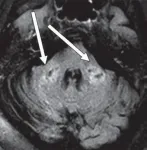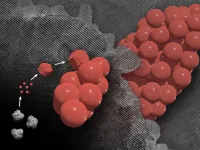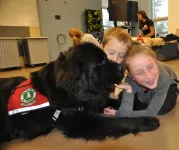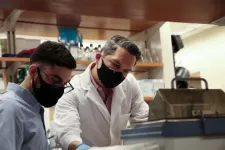Cosmetic laser may boost effectiveness of certain anti-cancer therapies
Combination treatment stimulates the immune system to attack multiple proteins on tumors.
2021-02-17
(Press-News.org) BOSTON - Use of a cosmetic laser invented at Massachusetts General Hospital (MGH) may improve the effectiveness of certain anti-tumor therapies and extend their use to more diverse forms of cancer. The strategy was tested and validated in mice, as described in a study published in Science Translational Medicine.
Immune checkpoint inhibitors are important medications that boost the immune system's response against various cancers, but only certain patients seem to benefit from the drugs. The cancer cells of these patients often have multiple mutations that can be recognized as foreign by the immune system, thereby inducing an inflammatory response.
In an attempt to expand the benefits of immune checkpoint inhibitors for additional patients, a team led by David E. Fisher, MD, PhD, director of the Mass General Cancer Center's Melanoma Program and director of MGH's Cutaneous Biology Research Center, conducted experiments in mice with a poorly immunogenic melanoma that is not hindered by immune checkpoint inhibitors. The researchers found that exposing the melanoma cells to ultraviolet radiation caused them to take on more mutations, which made immune checkpoint inhibitors more effective at boosting the immune response against the melanomas. Somewhat unexpectedly, the enhanced response included immune attack against non-mutated proteins in the tumor, a process called "epitope spreading."
"Epitope spreading could be important because many human cancers do not have very high mutation numbers, and correspondingly do not respond well to immunotherapy, so a treatment that can safely target nonmutated proteins could be valuable," Fisher explains.
The researchers next sought to find a substitute for the response triggered by mutations after ultraviolet radiation, since it's likely not safe to add mutations to a patient's tumor as a treatment strategy. "We discovered that use of a cosmetic laser, also known as a fractional laser, developed at MGH, when shined on a tumor, could trigger a form of local inflammation that mimicked the presence of mutations, strongly enhancing immune attacks against nonmutated tumor proteins, thereby curing many mice of tumors that otherwise did not respond to immunotherapy," says Fisher.
The findings suggest that using such a laser approach, or other methods to optimize immune responses against nonmutated targets on tumors, might make immune checkpoint inhibitors effective against currently incurable cancers.
INFORMATION:
This work was supported by the National Institutes of Health; the National Science Foundation; the Cancer Research Institute; the Leukemia and Lymphoma Society; the Dr. Miriam and Sheldon G. Adelson Medical Research Foundation; the Evergrande Center for Immunologic Diseases; Cancer Research UK; the Mildred Scheel Grant of the German Cancer Society; the Filling the Gap Grant of the University of Zurich, Switzerland; and the Swiss National Science Foundation.
About the Massachusetts General Hospital
Massachusetts General Hospital, founded in 1811, is the original and largest teaching hospital of Harvard Medical School. The Mass General Research Institute conducts the largest hospital-based research program in the nation, with annual research operations of more than $1 billion and comprises more than 9,500 researchers working across more than 30 institutes, centers and departments. In August 2020, Mass General was named #6 in the U.S. News & World Report list of "America's Best Hospitals."
ELSE PRESS RELEASES FROM THIS DATE:
2021-02-17
Leesburg, VA, February 17, 2021--According to an open-access article in ARRS' American Journal of Roentgenology (AJR), COVID-19-related disseminated leukoencephalopathy (CRDL) represents an important--albeit uncommon--differential consideration in patients with neurologic manifestations of coronavirus disease (COVID-19).
"Increasingly," wrote Colbey W. Freeman and colleagues from the University of Pennsylvania, "effects of COVID-19 on the brain are being reported, including acute necrotizing encephalopathy, infarcts, microhemorrhage, acute disseminated encephalomyelitis, and leukoencephalopathy."
Among the 2,820 patients with COVID-19 admitted to the authors' institution between ...
2021-02-17
When materials reach extremely small size scales, strange things begin to happen. One of those phenomena is the formation of mesocrystals.
Despite being composed of separate individual crystals, mesocrystals come together to form a larger, fused structure that behaves as a pure, single crystal. However, these processes happen at scales far too small for the human eye to see and their creation is extremely challenging to observe.
Because of these challenges, scientists had not been able to confirm exactly how mesocrystals form.
Now new research by a Pacific ...
2021-02-17
A considerable portion of the efforts to realize a sustainable world has gone into developing hydrogen fuel cells so that a hydrogen economy can be achieved. Fuel cells have distinctive advantages: high energy-conversion efficiencies (up to 70%) and a clean by-product, water. In the past decade, anion exchange membrane fuel cells (AEMFC), which convert chemical energy to electrical energy via the transport of negatively charged ions (anions) through a membrane, have received attention due to their low-cost and relative environment friendliness compared ...
2021-02-17
CHAMPAIGN, Ill. -- Researchers who focus on fat know that some adipose tissue is more prone to inflammation-related comorbidities than others, but the reasons why are not well understood. Thanks to a new analytical technique, scientists are getting a clearer view of the microenvironments found within adipose tissue associated with obesity. This advance may illuminate why some adipose tissues are more prone to inflammation - leading to diseases like type 2 diabetes, cancer and cardiovascular disorders - and help direct future drug therapies to treat obesity.
In a new study, University of Illinois ...
2021-02-17
A short-lived resurgence in the emission of ozone depleting pollutants in eastern China will not significantly delay the recovery of Earth's protective "sunscreen" layer, according to new research published Feb. 10 in Nature.
Stratospheric ozone, also known as Earth's ozone layer, helps shield us from the Sun's harmful Ultraviolet (UV) rays. Compounds like CFC-11 (Trichlorofluoromethane, also known as Freon-11), a chemical once considered safe and widely used as a refrigerant and in the production of insulation for buildings, rise to the stratosphere after emission on Earth's surface. Once in the atmosphere, CFC's are broken down by the UV light and result in the destruction of ozone molecules, both reducing stratospheric ozone concentrations globally ...
2021-02-17
A neural network system that analyzes photographs can rank and distinguish suspicious, potentially precancerous skin lesions, which can turn into the deadly skin malignancy melanoma if not caught and removed early. The system accurately scoped out suspicious lesions from 68 patients in a manner that mostly matched tried-and-true evaluations from dermatologists. The results suggest the platform could help clinicians spot suspicious lesions during clinical visits faster and on a larger scale, potentially allowing for earlier diagnosis and treatment. Melanoma is ...
2021-02-17
Understanding the molecular biology of brain tumors is key to prognosis and treatment said Le Bonheur Neuroscience Institute Co-Director Frederick Boop, MD, in his presentation "How Molecular Biology Impacts Clinical Practice" at the International Society for Pediatric Neurosurgery (ISPN) 2020 Virtual Meeting.
"Historically we have depended on what we see under a microscope to differentiate tumor types and determine prognosis and therapy," said Boop. "We know now that what we see doesn't necessarily predict how these tumors are going to behave."
Physicians are able to send a piece of a child's tumor to FoundationOne, an FDA-approved tissue-based broad companion diagnostic (CDx) for solid tumors, which provides the genomic alterations of that particular tumor. ...
2021-02-17
A new UBC Okanagan study finds children not only reap the benefits of working with therapy dogs-they enjoy it too.
"Dog lovers often have an assumption that canine-assisted interventions are going to be effective because other people are going to love dogs," says Nicole Harris, who conducted this research while a master's student in the School of Education. "While we do frequently see children improve in therapy dog programs, we didn't have data to support that they enjoyed the time as well."
Harris was the lead researcher in the study that explored how children reacted while participating in a social skill-training program with therapy dogs.
The research saw 22 children from the Okanagan Boys and Girls ...
2021-02-17
Resistance to tangle formation may help preserve memory
SuperAgers have fewer tangles than normally aging individuals
Future research to see how SuperAgers are protected
CHICAGO - A new Northwestern Medicine study showed cognitive SuperAgers have resistance to the development of fibrous tangles in a brain region related to memory and which are known to be markers of Alzheimer's disease.
The tangles are made of the tau protein which forms structures that transport nutrients within the nerve cell. These tangles disrupt the cell's transport system, ...
2021-02-17
Nearly a half-million people a year die from sudden cardiac death (SCD) in the U.S. -- the result of malfunctions in the heart's electrical system.
A leading cause of SCD in young athletes is arrhythmogenic cardiomyopathy (ACM), a genetic disease in which healthy heart muscle is replaced over time by scar tissue (fibrosis) and fat.
Stephen Chelko, an assistant professor of biomedical sciences at the Florida State University College of Medicine, has developed a better understanding of the pathological characteristics behind the disease, as well as promising avenues for ...
LAST 30 PRESS RELEASES:
[Press-News.org] Cosmetic laser may boost effectiveness of certain anti-cancer therapies
Combination treatment stimulates the immune system to attack multiple proteins on tumors.






